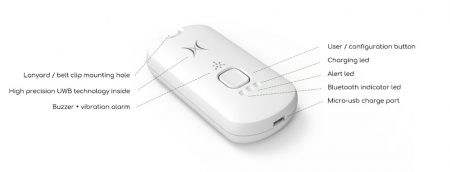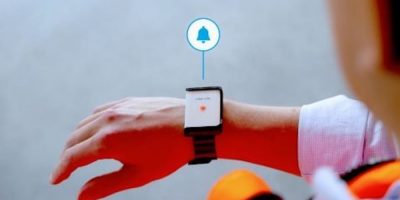Editors Blog – Keep your distance!
Wearable technology is stepping forward to ensure everyone keeps apart, in the fight to control the Covid-19 pandemic, says Caroline Hayes.
Most human beings have a clear sense of their personal space and that of others. Usually, we are wary of invading another’s personal space but in a world in the grip of a highly contagious disease people are having to remember to not only keep but extend their distance. It goes against every anthropomorphic socialising trait to conduct conversations or go about our daily business remembering to keep 2m (six feet) away from anyone else.
Motion, temperature and proximity sensors, combined with artificial intelligence are the main weapons used to ensure that people keep a safe distance from each other.
Now that much of Europe has been in lockdown for two months or more, there are tentative plans to start easing stay-in-place measures. Employees and employers are cautious about what this will mean. Ensuring staff keep a safe distance while being able to continue their work to help to revive the economies of the world is going to be a fine balancing act.
The German company, Kinexon, has developed SafeZone; the basic version is a SafeTag wristband to monitor distance. Used with accompanying software, it can also track those in the contact chain to identify and reduce those potentially at risk.
The wristband (Figure 1) actively warns the user, in real time, when the minimum physical distance limit is compromised. Software can allow companies to trace chains of infection. It does not process any personal data but does store data relating to critical contact events. In the event of a positive infection report, the software allows for contact analysis to identify anyone who has been in proximity and therefore at risk, using the sensor IDs.
There is no infrastructure required to being using SafeZone and it can be scaled to meet the needs of large or small organisations, says Kinexon.
One of the advantages of SafeZone is that it allows some freedom of movement and offers a way to begin the economic recovery and contribute to the well-being of staff who might be bored or listless in isolation.
“Instead of complete quarantines, which ultimately means a standstill in the company, we enable prevention strategies by maintaining minimum distances and precisely tracing infection chains,” said Kinexon’s co-founder and managing director, Dr Alexander Hüttenbrink.
The flexible SafeTag wristband has a sensor for physical distance measurement. The length of contact duration time can be specified and if either are breached, the SafeTag issues an audible and visual warning.
SafeZone can be used in offices and factories and is inexpensive, costing around 60 to 90 cents a day, compared to around €1 ($1.8 or £0.90) for a mask per day per employee, estimated Dr Oliver Trinchera, co-founder and managing director of Kinexon.
UWB technology
Using ultra-wideband (UWB) technology, SafeDistance also warns employees when they are violating social distancing guidelines. It has been developed by Lopos, a spin-off of the Belgium-based R&D hub, imec and the Ghent University, and is in volume production today. It is available from 27 May and initial pricing is from €99 per device.

Figure 2: SafeDistance uses ultra-wideband technology to let wearers down when social distance is violated.
Using UWB instead of Bluetooth technology increases the accuracy of distance measurement, says Lopos. The margin for error is 150mm maximum for UWB but two to five metres for Bluetooth. Selecting 1.65m as a distance parameter allows the wearer to be alerted if anyone is closer than 1.5m.
SafeDistance uses Lopos ultra wideband (UWB) technology, originated at imec and the Ghent University. When two wearables approach each other, the exact distance between the devices is measured and an audible or haptic alarm is activated, with an optional LED light signal, if the distancing guidelines are violated.
There have been pilot schemes at medium and large companies in the chemical, metal and construction industries, including AkzoNobel, where they reminded employees to respect the social distance of 1.5m in the workplace.
The device can be worn via a clip on a waistband or around the neck using a lanyard. There is no gateway, server or other infrastructure required for operation, confirmed Jen Rossey, CEO of Lopos. No personal data is logged.
Adding AI
Combining wearable devices and artificial intelligence, UK company, Tended, can track employees not just for social distancing but also for workplace safety.
Its wrist-worn Wearable is small and lightweight and uses sensor technology to detect accidents such as a trip or fall, and artificial intelligence (AI) to learn movement patterns and increase accuracy.
Tended’s Minimum Separation Distance technology automatically notifies workers if they come within a minimum distance of each other.

Figure 3: Tended’s UWB technology can be used to safeguard staff beyond the threat of Covid-19.
The UWB, IoT proximity tag and mobile communication device combine to ensure staff adhere to minimum separation measures.
Businesses can set the minimum separation distance they want to enforce; the Wearable will vibrate to notify the wearer to move away. The tag uses time-of-flight technology which is claimed to allow for incredibly high location accuracy and precision positioning. It is up to 12x more accurate than Bluetooth technology and is also much faster and less vulnerable to interference, said the company.
Social distancing breaches are recorded and displayed on Tended’s online dashboard, connected via a mobile app. This provides feedback on a business’ social distancing processes and areas for change, as well as insights into the effect of the change.
If someone receives a Covid-19 diagnosis, they can update their status within the app, which sends a real time alert to employers with a record of anyone they have been in close contact with. Employers can then send out a push notification to all the individuals that were in close contact with the affected employee for possible self-isolation and quarantining.
Outside of Covid-19 conditions, it can also be used for safety, remotely monitoring staff. It can be used, for example, to allow employees to check-in at a location and if there is no response, an emergency alert is triggered. AI is used for automated check-in. If movement is detected up to one minute before the scheduled check-in, the employee can be classified as safe without having to stop the task at hand to check-in.
An emergency alert can be used to a supervisor by holding down the screen on the Wearable for five seconds. The Wearable can also be set to check for movement, say every five minutes, and if there is no movement the Wearable will vibrate and the wearer has to be respond to confirm they are safe. If there is no response, an emergency alert is triggered.
The Wearable also includes a pedometer and Tended is developing other fitness features, such as distance travelled and calories burned.
The wearable market is responding well to the Covid-19 pandemic, with sensors and UWB technology to inform wearers of their surroundings and making us aware of unconscious behaviour. This is not something we are socially programmed to do, but in exceptional circumstances like today, technology has started to reprogramme our actions more than ever.
This article is exclusive to www.weartechdesign.com




